When I happened upon a Caledonia Yawl II at the 2019 WoodenBoat Show in Mystic, Connecticut, it was love at first sight. The original Caledonia Yawl, a rugged 19′ 6″ double-ended beach boat designed by Iain Oughtred for clinker plywood construction, has four strakes; this second iteration has seven, and was originally commissioned by a customer in Germany in 1999. The new design proved more stable for sailing while possibly sacrificing some rowing efficiency. Iain based his design of the Caledonia Yawl on the seaworthy double-ended working boats of the Hebrides, Scotland, his adopted home.I had built a Lumber Yard Skiff in 2017, a very simple 16′ design for first-time boatbuilders, and it was a major confidence-builder in my decision to take on the Caledonia Yawl II. That said, I don’t think previous building experience is a prerequisite; my skill level is at best described as a capable handyman around the house. Also, there are many tutorial videos available online that became indispensable during my project.The plans arrived with 17 pages of notes and 10 blueprint-style sheets of drawings, including full-sized patterns for the molds and stems. Lines and offsets are also included with ample information to loft the boat, although lofting is not required. I purchased CNC-cut molds and planks from Hewes & Company of Blue Hill, Maine. The planks are delivered in 8′ sections and must be carefully scarfed together.
Join The Conversation
We welcome your comments about this article. If you’d like to include a photo or a video with your comment, please email the file or link.

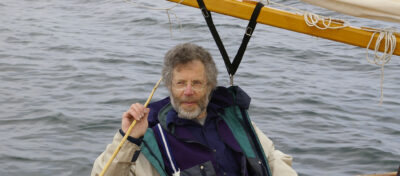
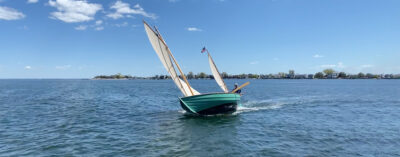
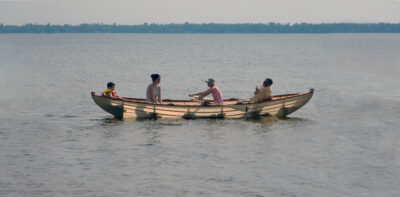

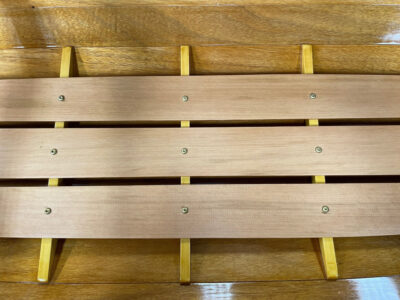
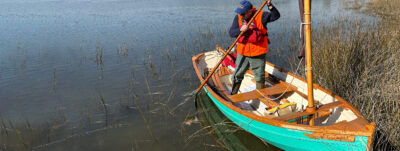
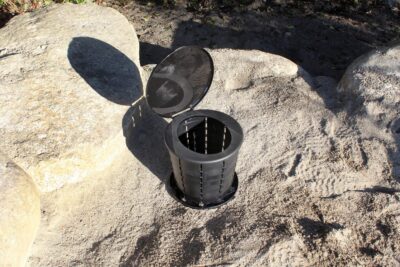
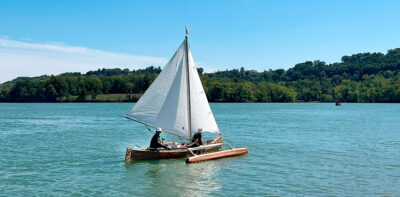
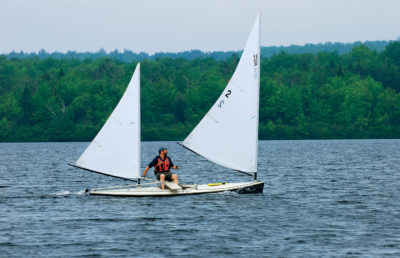
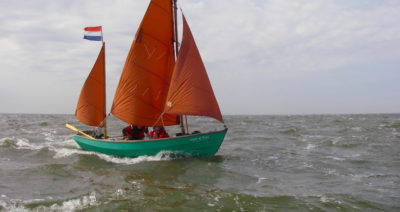
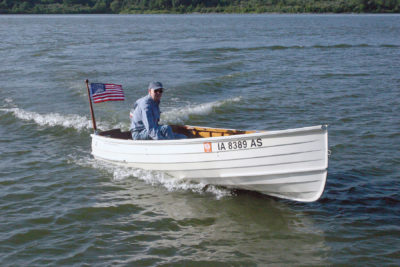

Donald – well done! Boat looks great. I am really pleased to find someone that has sailed both the lug and gunter version. I opted for the gunter on my CY and am preparing for my first season. One question: It looks like your boom on the gunter is on a gooseneck. Is that the case? If so, which one did you go for?
Cole,
I went with the “jaws”, as drawn on page 5 of 10 of the plans called Sail Plan II. They’re just a series of laminated pieces, and it worked very well with a cord and some parrel beads.
You will be very happy with the Gunter rig.
Cole,
I misspoke above, I was mistakenly referring to the laminated jaws on the yard. I also did jaws on the boom (much simpler) by just cutting out a shape on 3/4 marine plywood and gluing to the boom. I can send a pic if you’d like. Also closed this jaw with cord and parrel beads. A jaw in this application is nice because it slides up and down, some goosenecks are rigid. Sorry for the confusion.
Very lovely! Beautiful job; beautiful design. Ian will be sorely missed.
I was interested in your experiences with the two different rigs. I had a 12ft skiff that I first rigged with a lug rig, but found that tensioning the luff to give decent windward performance would cause the mast to bend substantially, due the compression load, which would then allow the luff of the sail to sag away again. I changed the rig to gaff; then the mast bend acted to flatten the sail in stronger winds, rather than get fuller as happened with the lug rig.
Andy,
The birds-mouth construction of my main mast makes it amazingly stiff, so I haven’t had that problem, although I understand what your saying . . . a sagging luff on a lug rig can be very debilitating, whatever the cause. Sounds like you made a good solution.
A loop of parrel beads would help hold the lug’s yard against the mast. This is a common solution.
You did a beautiful job on your boat. I have owned the plans for 20 years or more, and now that I am past my mid 80s, I fear I may not get around to building. I do scan the classifieds from time to time hoping one might show up. I would be quite content with the 4-plank hull as opposed to the 7-plank one. I see some CYs with outboard motor wells, but it looks like your situation allows you to depend on oars; it;’s always nice to dispense with the stinky noise makers.
David, thanks for your note, I recommend offcenterharbor.com, they have a boats for sale section which often has one or two Caledonia Yawls in it.
And you are right, no outboard for me. However, I have seen folks add lightweight electric motors on nice simple brackets, something I may think about as well as I get older.
Nice boat. I also have a Caledonia II rigged with a balanced lug for simplicity and ease of set up. I have not added a mizzenmast yet but am interested in trying it to see how much difference it will make. I, like you, love cruising in it.
Wayne, I think you should try the mizzen, it will give you two wonderful things. First, with the mizzen sheeted in tight, she will keep the boat head-to-wind while raising and lowering the mainsail. And two, just slight adjustments to the mizzen will eliminate any weather helm and keep the boat very balanced. It’s also very good-looking.
Donald, interesting that you have tried both lug and Gunter versions. I built Oughtred’s Sooty Tern, which is a narrower version of the CY.
On another matter: I too will be sailing on L. I. Sound. I noticed no CT registration number. I don’t really want to mar my boat with 3” numbers, but wonder about compliance. Any sailboat over 19’6” is supposed to have a vessel registration. Furthermore I worry that I’ll have to have a USCG inspection with possible annoyances like requiring built-in flotation. What’s your thinking on this?
Malcolm Meldahl
Deep River, CT
Don’s Caledonia finished shorter than the designed LOA and fell just shy of requiring registration.
—Ed.
Malcom, in addition to Chris’ comment above, I did add inflatable boat rollers under the side seats as floatation, which more than covers the Connecticut requirements.
Hi Don
We seem to have some common experiences with the CY2. I built mine in 2019 (see AUDREY JAMES in the April 2020 Small Boats). A very fun and delightful open-air driveway build. Once it hit the water the discoveries started. I also have the balanced lug with mizzen. I have since fabricated a short bowsprit for a roller jib. This has been a great improvement in handling and sailing abilities. I sail with 1 reef 80% of the time due to the southwest breeze kicking up pretty quickly here in Narragansett Bay, RI. I keep the mizzen reefed also. The jib makes up for the reefed main with less sail aloft. I have a double block downhaul and mainsheet. I put a single block purchase on the main halyard to ease the load while setting and striking ( have one hand free to grab the sail & yard). My small electric motor didn’t quite do the job so I have a 2.3 hp to keep me out of trouble. The motor also allows me to enter areas I normally wouldn’t go. No capsizes yet! I camp-cruise Narragansett Bay and some of the larger CT & RI lakes and salt ponds. Considering the Connecticut River this year. Perhaps we’ll cross wakes.
Nice work!
Marty Casey
Marty – can you share more information on how you set up your balanced lug/mizzen with the bowsprit/roller jib? Contemplating different riggings for my build, and this is an interesting addition without going full change to gunter yawl rig?
Thanks!
Jason
Marty, thanks for your note . . . your boat looks beautiful. If you have a picture of her under sail with the bow sprit and jib, please post.
No pics with jib set. Stay tuned…early lauching soon.
Great story, beautiful boat. I’m playing with boats on the other side of the Sound.
I also had a 20′ Pennant Sloop, loved that boat.
I have found it a pleasant pastime to build scale models of the boats I like. My first was a solid wood model of an H28 (Herreshoff ketch) that appeared in one of the boat-building magazines. (I heard that GIs returning from WWII fell in love with that design). I built that instead of studying at my desk while in college. Later I built a Ted Brewer 22′ ketch designed for plywood construction, and planked it up with thin red cedar that I cut on the table saw. Have done the same with a John Gardner Swampscott dory, a Bolger double-chine outboard skiff, and also a 9′ round-bilge pram in Chapelle’s Small Boats. For that one, I lofted the lines and built a mold frame just as you would in building the real thing. Lining off the plank shapes for this lapstrake dinghy was an interesting task. As I was trying to bend in tiny ash frames, I got frustrated when the frames almost instantly cooled off from the teakettle steaming. That’s when I tried bending with dry heat; it was winter, and I was standing next to a hot stove pipe, when I got this inspiration. Oh, also did a model of a Bolger outboard skiff with a double-chine hull. All of these smaller boats I did at a 1″ to 1′ scale, just to simplify the math.
Though I made my own “lumber” on the table saw, hobby shops often have extremely thin plywood that should work very well.
I recommend anyone contemplating building a boat to build a scale model first. It should take you hours, or at most days, instead of months or years. You get to see what the 3-dimensional boat will look like, and can also deal with complications and dilemmas that might intimidate you on the full-size vessel.
I miss the days when boat-building magazines featured plans you could build from, though of course they wanted you to buy the actual blue prints from the designer. These included “Sports Afield’s Boatbuilding Annual,” “How to Build 20 Boats,” “Boats You Can Build” and “MoTorBoat’s Ideal Series,” which consisted mostly of Billy Atkin’s designs. One of his most intriguing is “Pocahontas,” a 12′ gaff-rigged, teak planked (lapstrake) sloop of 1400 lbs. displacement (!). Haven’t tackled that one yet, but it is tempting. It is really a little ship, with actual deadeyes instead of turnbuckles for the standing rigging.